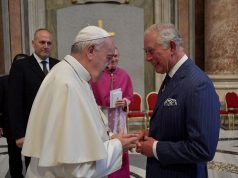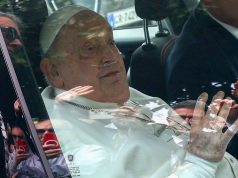
VATICAN— A new document from the Dicastery for the Doctrine of the Faith published on Friday, May 17, has updated the norms for discerning alleged supernatural phenomena. The norms come into force on Sunday, May 19, the feast of Pentecost.
The document is preceded by a detailed presentation by Cardinal Víctor Manuel Fernández, Prefect of the Dicastery, followed by an introduction and six possible conclusions. The procedure allows for faster decisions while respecting popular devotion.
As a rule, the Church’s authority will no longer be engaged to officially define the supernatural nature of a phenomenon, a process that can require large amounts time to thoroughly study an event.
Another new norm involves the explicit involvement of the Dicastery for the Doctrine of the Faith, which must approve the local bishop’s final decision and which has the authority to intervene motu proprio at any time.
Many cases in recent decades have involved the former Holy Office, even when individual bishops have expressed themselves. However, the interventions have usually remained behind the scenes and were never made public.
The Dicastery’s new explicit involvement also relates to the difficulty in circumscribing phenomena, which in some cases reach national and even global dimensions, “meaning that a decision made in one Diocese has consequences also elsewhere.”
Reasons for the new norms
The document originates from the long experience of the last century, which saw cases where the local bishop (or bishops of a region) rapidly declared a phenomenon’s supernatural nature, only for the Holy Office to express a different decision later. Other cases involved a bishop saying one thing and his successor deciding the opposite (regarding the same phenomenon).
Each event also required lengthy discernment periods to evaluate all elements in order to reach a decision on the supernatural nature or non-supernatural nature of the phenomena. These time periods sometimes contrasted with the urgency to give pastoral responses for the good of the faithful.
The Dicastery began revising the norms in 2019, leading to the current text approved by Pope Francis on May 4.
Spiritual fruits and risks
In his presentation, Cardinal Fernández explains that, “many times, these events have led to a great richness of spiritual fruits, growth in faith, devotion, fraternity, and service. In some cases, they have given rise to shrines throughout the world that are at the heart of many people’s popular piety today.”
However, there is also the possibility that “in some events of alleged supernatural origin,” serious issues that harm the faithful may arise. These include cases where from the alleged phenomena, “profit, power, fame, social recognition, or other personal interest” (II, Art. 15, 4°) are derived, even to the point of “exerting control over people or carrying out abuses (II, Art. 16).”
There may be “doctrinal errors, an oversimplification of the Gospel message, or the spread of a sectarian mentality.” There is the possibility of believers “being misled by an event that is attributed to a divine initiative but is merely the product of someone’s imagination, desire for novelty, tendency to fabricate falsehoods (mythomania), or inclination toward lying.”
General guidelines
According to the new norms, the Church will exercise her duties of discernment, based on the following:
“(a) whether signs of a divine action can be ascertained in phenomena that are alleged to be of supernatural origin; (b) whether there is anything that conflicts with faith and morals in the writings or messages of those involved in the alleged phenomena in question; (c) whether it is permissible to appreciate their spiritual fruits, whether they need to be purified from problematic elements, or whether the faithful should be warned about potential risks; (d) whether it is advisable for the competent ecclesiastical authority to realize their pastoral value” (I, 10).
However, “it is not foreseen in these Norms that ecclesiastical authority would give a positive recognition of the divine origin of alleged supernatural phenomena” (I, 11).
Therefore, as a rule, “neither the Diocesan Bishop, nor the Episcopal Conferences, nor the Dicastery will declare that these phenomena are of supernatural origin, even if a Nihil obstat is granted. It remains true, however, that the Holy Father can authorize a special procedure in this regard” (I, 23).
Possible conclusions regarding an alleged phenomenon
The discernment of an alleged supernatural phenomenon may reach the following six conclusions.
– Nihil Obstat: Without expressing any certainty about the supernatural authenticity of the phenomenon itself, many signs of the action of the Holy Spirit are acknowledged. The bishop is encouraged to appreciate the pastoral value and promote the dissemination of the phenomenon, including pilgrimages;
– Prae oculis habeatur: Although important positive signs are recognized, some aspects of confusion or potential risks are also perceived that require the diocesan bishop to engage in a careful discernment and dialogue with the recipients of a given spiritual experience. If there were writings or messages, doctrinal clarification might be necessary;
– Curatur: Various or significant critical elements are noted, but the phenomenon is already spread widely, and verifiable spiritual fruits are connected to it. Therefore, a ban that could upset the faithful is not recommended, but the local bishop is advised not to encourage the phenomenon;
– Sub mandato: The critical issues are not connected to the phenomenon itself but to its improper use by people or groups, such as undue financial gain or immoral acts. The Holy See entrusts the pastoral leadership of the specific place to the diocesan bishop or a delegate;
– Prohibetur et obstruatur: Despite various positive elements, the critical issues and risks associated with this phenomenon appear to be very serious. The Dicastery asks the local bishop to offer a catechesis that can help the faithful understand the reasons for the decision and reorient their legitimate spiritual concerns;
– Declaratio de non supernaturalitate: The Dicastery for the Doctrine of the Faith authorizes the local bishop to declare that the phenomenon is found to be not supernatural based on concrete facts and evidence, such as the confession of an alleged visionary or credible testimonies of fabrication of the phenomenon.
Procedures to follow
The new norms then indicate the procedures to be implemented. It is up to the diocesan bishop to examine cases and submit their judgment to the Dicastery for approval. The bishop is asked to refrain from making public declarations about the authenticity or supernatural nature and to ensure there is no confusion or sensationalism.
If the elements of the case “seem sufficient,” the diocesan bishop will then set up an investigative commission, which should include at least one theologian, one canonist, and an expert chosen based on the nature of the phenomenon.
Positive and negative criteria
The document lays out several positive criteria to evaluate the alleged supernatural phenomenon.
These include: “the credibility and good reputation of the persons who claim to be recipients of supernatural events or to be directly involved in them, as well as the reputation of the witnesses who have been heard…; the doctrinal orthodoxy of the phenomenon and any messages related to it; the unpredictable nature of the phenomenon, by which it is evident that it is not the result of the initiative of the people involved; and, fruits of the Christian life” (II, 14).
The negative criteria involve: “the possibility of a manifest error about the event; potential doctrinal errors…; a sectarian spirit that breeds division in the Church; an overt pursuit of profit, power, fame, social recognition, or other personal interest closely linked to the event; gravely immoral actions…; psychological alterations or psychopathic tendencies in the person that may have exerted an influence on the alleged supernatural event; and, any psychosis, collective hysteria, and other elements traceable to a pathological context” (II, 15).
Finally, “the use of purported supernatural experiences or recognized mystical elements as a means of or a pretext for exerting control over people or carrying out abuses” (II, 16) is considered of particular moral gravity.
Regardless of the final approved determination, the diocesan bishop “must continue to watch over the phenomenon and the people involved, exercising his ordinary power” (II, 24).









